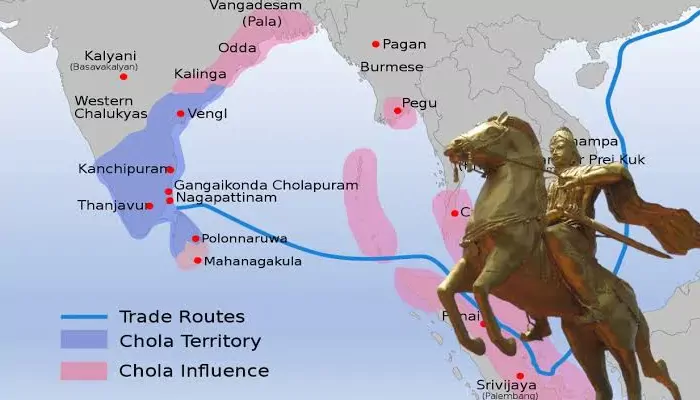
These feuds didn’t just change thrones—they changed the subcontinent!
Beyond culture, art, and dynasties—India’s history is packed with epic rivalries that weren’t just personal. They were simply political. These weren’t everyday “who-inherited-the-jewels” tiffs. These were full-blown power clashes that somewhat reshaped kingdoms, split empires, and even gave birth to entirely new states.
So buckle up. Because you're not going through monotonous history lecture. We’re taking you on a high-octane royal drama—where crowns were earned by conquest, and ego sometimes mattered more than empire.
The Cholas and Chalukyas weren’t just neighbors—they were nemeses. This centuries-long conflict across Southern part of India witnessed multiple battles, shifting alliances, and so many palace plotting that can vividly designed into multi-season political thriller webseries.
Rajaraja Chola I and his son Rajendra Chola expanded the Chola Empire with strategic naval brilliance, but it was their clashes with the Western Chalukyas under Vikramaditya VI that lit the map on fire—literally and figuratively. Towns were razed. Temples were captured. And borderlines were pushed with every war. Both dynasties fought to carve their names in stone—sometimes quite literally, in temple inscriptions.

Let's delve into an eternal love-hate saga. On one side, there were mighty Mughals, led by emperors like Akbar and Aurangzeb. On the other: the sword-swinging Rajputs—especially the indomitable Maharana Pratap of Mewar.
For years, Akbar tried to settle down everything with diplomacy—marriages, titles, and alliances. But Maharana Pratap wasn’t ready to accept this trap. The Battle of Haldighati in 1576 wasn’t just a military clash. It was a statement between Rajput’s pride and Mughal’s aggressive expansion.
The Mughals may have won the battle, but that didn’t break the spirit of Rajputs. The rivalry created several fractured zones, fortified cities, and resistance pockets that shaped North-western India's map for generations.
In the Deccan, it was a tug of war between the fast growing Maratha Empire and the well-established Nizam of Hyderabad. Led by fierce warriors like Peshwa Baji Rao I, the Marathas were on an expansion spree. But the Nizams had different plans. The rivalry peaked during the Battle of Palkhed (1728), where Baji Rao outsmarted the Nizam using swift cavalry tactics.
Beyond a military win—it was a strategic masterclass that redefined the power dynamics in Central part of India. With these battles, the borders of Maharashtra and Hyderabad evolved.
While it didn’t make huge headlines, the tension between Mysore under Tipu Sultan and the Travancore royal family was real! Tipu had a plan to dominate all of southern India, but Travancore stood as a barrier. The Travancoreans built the Nedumkotta (a giant fortification) to prevent Tipu’s advance. That lead to Battles, failed treaties and during this complicated time, alliances were tested.
Eventually, the Travancore tied up with the British rulers. But, this regional rivalry redefined control in Kerala and southern Karnataka, rewriting geography.
Technically, it was not a royal-vs-royal feud. But the Nawab of Bengal, Siraj-ud-Daulah, found himself in an epic three-way storm—against the British, his own courtiers, and rival Nawabs. The betrayal at the Battle of Plassey (1757) by Mir Jafar wasn’t just treachery, it was a power play that redrew not just the maps but India's destiny. The epic fall of Siraj didn’t just change Bengal’s territory—it opened the floodgates for British colonization. So the sibling drama ultimately changed Indian borders forever.
In history books, emperors and reformers are credited for shaping the Indian subcontinent. But let’s be real—these above-mentioned feuds did half the job. Rivalries pushed kingdoms to expand, shrink, split, or even disappear. Alliances rose for years and then suddenly fell. Borders were redesigned not in boardrooms, but on battlefields. From brothers turning into enemies or neighbors becoming nemeses, these clashes weren’t only about crowns—they were about power, ego and control.
So the next time you observe India’s map, remember—it hasn't been the same throughout. Behind the state lines lie stories of revenge, resilience, conspiracy and royal rage. These were no fictional plays. These real and ruthless stories have reshaped the future of millions.